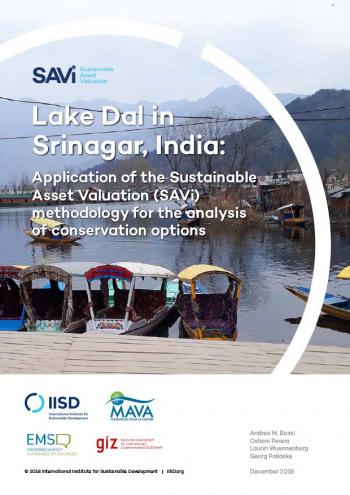| 来源类型 | Report
|
| 规范类型 | 报告
|
| Lake Dal in Srinagar, India: Application of the Sustainable Asset Valuation (SAVi) methodology for the analysis of conservation options |
| Andrea Bassi; Oshani Perera; Laurin Wuennenberg; Georg Pallaske
|
| 发表日期 | 2018-12
|
| 出版者 | IISD
|
| 出版年 | 2018
|
| 页码 | 103
|
| 语种 | 英语
|
| 概述 | The report presents the interim results of the SAVi analysis for developing the business case for the long-term conservation of Lake Dal in Srinagar, India. |
| 摘要 |
Key Messages - The SAVi analysis highlights that more effective and systemic measures for reducing pressures on the lake need to be implemented instead of treating only the symptoms of pollution.
- If the ecological collapse of Lake Dal is to be prevented and fishing activities maintained over time, then business as usual or interventions such as a proposed road construction project and treating sewage solely from lake dwellers and houseboats are all either counterproductive or insufficient approaches.
- A hybrid infrastructure solution is most cost-effective for reducing pollution pressures and for generating economic benefits in the region. This solution combines sewage treatment infrastructure upgrades and the construction of an artificial wetland.
IISD was invited by the state Government of Jammu & Kashmir to use the Sustainable Asset Valuation (SAVi) tool to develop the business case for the long-term conservation of Lake Dal. The lake has long suffered from anthropogenic pressures including encroachment, water extraction, discharge of untreated domestic sewage and fertilizer runoff. This has led to a sharp decrease in water quality, increased eutrophication and further cascading effects such as declining fish stocks and reduced recreational attractiveness.
The report presents the interim results of the SAVi simulation and analysis. By considering Lake Dal and the surrounding area as an interconnected economic, environmental and social "system," impacts of competing users and associated sources of pollution on the lake's water quality were assessed. SAVi was then used to simulate how a clean and productive lake would increase revenues for associated industries such as tourism and fisheries. The SAVi analysis is organized under a range of scenarios, including business as usual, grey infrastructure interventions, natural infrastructure interventions, relocation of lake dwellers and road construction.
The analysis reveals important insights for formulating policies and prioritizing conservation measures. More effective and systemic measures for reducing pressures on the lake need to be implemented urgently instead of treating only the symptoms of pollution such as algae growth. The analysis highlights that neither business as usual nor the incautious construction of a proposed road along the lake are viable options if the ecological collapse of Lake Dal is to be prevented and fishing activities maintained over time. Neither will it be sufficient to address sewage pressures caused solely by lake dwellers or houseboats.
Deploying a hybrid infrastructure solution is most cost-effective for reducing pollution pressures and for generating economic benefits in the region. The scenario envisions the simultaneous implementation of four interventions: (i) establishing sewage network connectivity and sewage treatment capacity for treating sewage from inhabitants living in the periphery of the lake; (ii) installing solar photovoltaic to provide reliable and emission-free electricity to the sewage treatment infrastructure to avoid accidental discharge during power cuts; (iii) implementing on-site sewage treatment for lake dwellers and houseboats; and (iv) the construction of an artificial wetland. |
| 主题 | Public Procurement and Infrastructure Finance
; Water Science and Policy
|
| URL | https://www.iisd.org/library/lake-dal-srinagar-india-application-sustainable-asset-valuation-savi-methodology-analysis
|
| 来源智库 | International Institute for Sustainable Development (Canada)
|
| 资源类型 | 智库出版物
|
| 条目标识符 | http://119.78.100.153/handle/2XGU8XDN/56507
|
推荐引用方式
GB/T 7714 |
Andrea Bassi,Oshani Perera,Laurin Wuennenberg,et al. Lake Dal in Srinagar, India: Application of the Sustainable Asset Valuation (SAVi) methodology for the analysis of conservation options. 2018.
|
|
文件名:
|
savi-dal-lake-india-1.jpg
|
|
格式:
|
JPEG
|

|
文件名:
|
savi-dal-lake-india.pdf
|
|
格式:
|
Adobe PDF
|
此文件暂不支持浏览
除非特别说明,本系统中所有内容都受版权保护,并保留所有权利。